Monitoring Land Use Land Cover Changes and Modelling of Urban Growth Using a Future Land Use Simulation Model (FLUS) in Diyarbakır, Turkey
Abstract
:1. Introduction
2. Materials and Methods
2.1. Research Area
2.2. Data Type and Source
2.3. LULC Classification
2.3.1. Pre-Processing of Satellite Data
2.3.2. Object Based Classification
2.3.3. Accuracy Assessment
2.4. Land Change Modeler and Trend Analysis
2.5. FLUS Model
3. Results
3.1. LULC Classes
3.2. Accuracy Assessment of LULC
3.3. LULC Change Detection Analysis
3.4. LULC Trend Analysis
3.5. Simulation of LULC Classes
3.6. Accuracy Assessment of LULC Simulation
4. Discussion and Conclusions
Author Contributions
Funding
Institutional Review Board Statement
Informed Consent Statement
Data Availability Statement
Acknowledgments
Conflicts of Interest
References
- Xu, X.; Guan, M.; Jiang, H.; Wang, L. Dynamic Simulation of Land Use Change of the Upper and Middle Streams of the Luan River, Northern China. Sustainability 2019, 11, 4909. [Google Scholar] [CrossRef] [Green Version]
- Ritse, V.; Basumatary, H.; Kulnu, A.S.; Dutta, G.; Phukan, M.M.; Hazarika, N. Monitoring Land Use Land Cover Changes in the Eastern Himalayan Landscape of Nagaland, Northeast India. Environ. Monit. Assess. 2020, 192, 711. [Google Scholar] [CrossRef]
- Ganaie, T.A.; Jamal, S.; Ahmad, W.S. Changing Land Use/Land Cover Patterns and Growing Human Population in Wular Catchment of Kashmir Valley, India. GeoJournal 2021, 86, 1589–1606. [Google Scholar] [CrossRef]
- Negewo, T.; Sarma, A. Anthropogenic Land Use/Cover Change Detection and Its Impacts on Hydrological Responses of Genale Catchment, Ethiopia. Res. Sq. 2021. [Google Scholar] [CrossRef]
- Alam, A.; Bhat, M.S.; Maheen, M. Using Landsat Satellite Data for Assessing the Land Use and Land Cover Change in Kashmir Valley. GeoJournal 2020, 85, 1529–1543. [Google Scholar] [CrossRef] [Green Version]
- Al Kafy, A.; Naim, M.N.H.; Subramanyam, G.; Faisal, A.A.; Ahmed, N.U.; Rakib, A.A.; Kona, M.A.; Sattar, G.S. Cellular Automata Approach in Dynamic Modelling of Land Cover Changes Using RapidEye Images in Dhaka, Bangladesh. Environ. Challenges 2021, 4, 100084. [Google Scholar] [CrossRef]
- Mishra, V.; Rai, P.; Mohan, K. Prediction of Land Use Changes Based on Land Change Modeler (LCM) Using Remote Sensing: A Case Study of Muzaffarpur (Bihar), India. J. Geogr. Inst. Jovan Cvijic SASA 2014, 64, 111–127. [Google Scholar] [CrossRef]
- Gounaridis, D.; Chorianopoulos, I.; Koukoulas, S. Exploring Prospective Urban Growth Trends under Different Economic Outlooks and Land-Use Planning Scenarios: The Case of Athens. Appl. Geogr. 2018, 90, 134–144. [Google Scholar] [CrossRef]
- Hadgu, K.M. Temporal and Spatial Changes in Land Use Patterns and Biodiversity in Relation to Farm Productivity at Multiple Scales in Tigray, Ethiopia; Wageningen University: Wageningen, The Netherlands, 2008. [Google Scholar]
- Lambin, E.F.; Meyfroidt, P. Global Land Use Change, Economic Globalization, and the Looming Land Scarcity. Proc. Natl. Acad. Sci. USA 2011, 108, 3465–3472. [Google Scholar] [CrossRef] [Green Version]
- Hamad, R.; Balzter, H.; Kolo, K. Predicting Land Use/Land Cover Changes Using a CA-Markov Model under Two Different Scenarios. Sustainability 2018, 10, 3421. [Google Scholar] [CrossRef] [Green Version]
- Metzger, M.J.; Rounsevell, M.D.A.; Acosta-Michlik, L.; Leemans, R.; Schröter, D. The Vulnerability of Ecosystem Services to Land Use Change. Agric. Ecosyst. Environ. 2006, 114, 69–85. [Google Scholar] [CrossRef]
- Calzada, L.; Meave, J.A.; Bonfil, C.; Figueroa, F. Lands at Risk: Land Use/Land Cover Change in Two Contrasting Tropical Dry Regions of Mexico. Appl. Geogr. 2018, 99, 22–30. [Google Scholar] [CrossRef]
- Aksoy, H.; Kaptan, S. Monitoring of Land Use/Land Cover Changes Using GIS and CA-Markov Modeling Techniques: A Study in Northern Turkey. Environ. Monit. Assess. 2021, 193, 507. [Google Scholar] [CrossRef]
- Marraccini, E.; Debolini, M.; Moulery, M.; Abrantes, P.; Bouchier, A.; Chéry, J.P.; Sanz Sanz, E.; Sabbatini, T.; Napoleone, C. Common Features and Different Trajectories of Land Cover Changes Insix Western Mediterranean Urban Regions. Appl. Geogr. 2015, 62, 347–356. [Google Scholar] [CrossRef]
- Vitousek, P.M.; Mooney, H.A.; Lubchenco, J.; Melillo, J.M. Human Domination of Earth’s Ecosystems. Science 1997, 277, 494–499. [Google Scholar] [CrossRef] [Green Version]
- Mendiratta, P.; Gedam, S. Assessment of Urban Growth Dynamics in Mumbai Metropolitan Region, India Using Object-Based Image Analysis for Medium-Resolution Data. Appl. Geogr. 2018, 98, 110–120. [Google Scholar] [CrossRef]
- Kaya, A.Y. Enes Karadeniz Afet Sonrası Kent ve Planlama: Elazığ Örneği. In Depremler, Kent Planlama ve Geoteknik Zemin Uygulamaları; Güner, A.B.S., Ed.; Iksad Publications: Ankara, Turkey, 2020; pp. 65–96. ISBN 978-625-7279-88-8. [Google Scholar]
- Cui, N.; Feng, C.C.; Han, R.; Guo, L. Impact of Urbanization on Ecosystem Health: A Case Study in Zhuhai, China. Int. J. Environ. Res. Public Health 2019, 16, 4717. [Google Scholar] [CrossRef] [Green Version]
- Seto, K.C.; Güneralp, B.; Hutyra, L.R. Global Forecasts of Urban Expansion to 2030 and Direct Impacts on Biodiversity and Carbon Pools. Proc. Natl. Acad. Sci. USA 2012, 109, 16083–16088. [Google Scholar] [CrossRef] [Green Version]
- Alphan, H. Land-Use Change and Urbanization of Adana, Turkey. Land Degrad. Dev. 2003, 14, 575–586. [Google Scholar] [CrossRef]
- Tanrivermis, H. Agricultural Land Use Change and Sustainable Use of Land Resources in the Mediterranean Region of Turkey. J. Arid Environ. 2003, 54, 553–564. [Google Scholar] [CrossRef]
- Verburg, P.H.; Schot, P.P.; Dijst, M.J.; Veldkamp, A. Land Use Change Modelling: Current Practice and Research Priorities. GeoJournal 2004, 61, 309–324. [Google Scholar] [CrossRef]
- Kourosh Niya, A.; Huang, J.; Kazemzadeh-Zow, A.; Karimi, H.; Keshtkar, H.; Naimi, B. Comparison of Three Hybrid Models to Simulate Land Use Changes: A Case Study in Qeshm Island, Iran. Environ. Monit. Assess. 2020, 192, 302. [Google Scholar] [CrossRef] [PubMed]
- Aburas, M.M.; Ho, Y.M.; Ramli, M.F.; Ash’aari, Z.H. The Simulation and Prediction of Spatio-Temporal Urban Growth Trends Using Cellular Automata Models: A Review. Int. J. Appl. Earth Obs. Geoinf. 2016, 52, 380–389. [Google Scholar] [CrossRef]
- Shafizadeh-Moghadam, H.; Asghari, A.; Taleai, M.; Helbich, M.; Tayyebi, A. Sensitivity Analysis and Accuracy Assessment of the Land Transformation Model Using Cellular Automata. GIScience Remote Sens. 2017, 54, 639–656. [Google Scholar] [CrossRef]
- Alan, İ.; Demirörs, Z.; Bayar, R.; Karabacak, K. Markov Zincirleri Temelli Arazi Örtüsü Tahmin Modeli Geliştirilmesi: Ankara İli Örneği. lnternational J. Geogr. Geogr. Educ. 2020, 42, 650–667. [Google Scholar] [CrossRef]
- Girma, R.; Fürst, C.; Moges, A. Land Use Land Cover Change Modeling by Integrating Artificial Neural Network with Cellular Automata-Markov Chain Model in Gidabo River Basin, Main Ethiopian Rift. Environ. Challenges 2022, 6, 100419. [Google Scholar] [CrossRef]
- Liu, X.; Liang, X.; Li, X.; Xu, X.; Ou, J.; Chen, Y.; Li, S.; Wang, S.; Pei, F. A Future Land Use Simulation Model (FLUS) for Simulating Multiple Land Use Scenarios by Coupling Human and Natural Effects. Landsc. Urban Plan. 2017, 168, 94–116. [Google Scholar] [CrossRef]
- Guo, H.; Cai, Y.; Yang, Z.; Zhu, Z.; Ouyang, Y. Dynamic Simulation of Coastal Wetlands for Guangdong-Hong Kong-Macao Greater Bay Area Based on Multi-Temporal Landsat Images and FLUS Model. Ecol. Indic. 2021, 125, 107559. [Google Scholar] [CrossRef]
- Zhang, D.; Wang, X.; Qu, L.; Li, S.; Lin, Y.; Yao, R.; Zhou, X.; Li, J. Land Use/Cover Predictions Incorporating Ecological Security for the Yangtze River Delta Region, China. Ecol. Indic. 2020, 119, 106841. [Google Scholar] [CrossRef]
- Tözün, V. Diyarbakır Şehir Coğrafyası. Dil ve Tar. Coğrafya Fakültesi Yıllık Araştırmalar Derg. 1941, 1, 481–498. [Google Scholar]
- Karadoğan, S. Yerleşmeye Etkileri Açısından Diyarbakır Kenti ve Yakın Çevresinin Doğal Peyzaj Unsurları. In Diyarbakır Kalesi ve Hevsel Bahçeleri kültürel peyzajı; Soylukaya, N., Ed.; Diyarbakır Büyükşehir Belediyesi Yayınları: Diyarbakır, Turkey, 2015; pp. 1–16. [Google Scholar]
- Roy, D.P.; Wulder, M.A.; Loveland, T.R.; Woodcock, C.E.; Allen, R.G.; Anderson, M.C.; Helder, D.; Irons, J.R.; Johnson, D.M.; Kennedy, R.; et al. Landsat-8: Science and Product Vision for Terrestrial Global Change Research. Remote Sens. Environ. 2014, 145, 154–172. [Google Scholar] [CrossRef] [Green Version]
- Aksoy, H.; Kaptan, S.; Varol, T.; Cetin, M.; Ozel, H.B. Exploring Land Use/Land Cover Change by Using Density Analysis Method in Yenice. Int. J. Environ. Sci. Technol. 2022. [Google Scholar] [CrossRef]
- Tombuş, F.E. Çorum İli ve Yakın Çevresinin Uzaktan Algılama Yöntemleri Ile Arazi Kullanımının Değerlendirilmesi; Ankara Üniversitesi: Ankara, Turkey, 2019. [Google Scholar]
- Balçık, F.B.; Göksel, Ç. SPOT 5 ve farklı görüntü birleştirme algoritmaları. Jeodezi Jeoinformasyon Derg. 2010, 101. Available online: https://dergipark.org.tr/en/pub/hkmojjd/issue/53143/704637 (accessed on 24 May 2022).
- Rimal, B.; Zhang, L.; Keshtkar, H.; Haack, B.N.; Rijal, S.; Zhang, P. Land Use/Land Cover Dynamics and Modeling of Urban Land Expansion by the Integration of Cellular Automata and Markov Chain. ISPRS Int. J. Geo-Inf. 2018, 7, 154. [Google Scholar] [CrossRef] [Green Version]
- Altuntaş, C. Özşen Çorumluoğlu Uzaktan Algılama Görüntülerinde Digital Görüntü Işleme ve RSImage Yazılımı. In Proceedings of the Selçuk Üniversitesi Jeodezi ve Fotogrametri Mühendisliği Öğretiminde 30. Yıl Sempozyumu, Konya, Turkey, 16–18 October 2002; pp. 434–442. [Google Scholar]
- Sertel, E.; Robock, A.; Ormeci, C. Impacts of Land Cover Data Quality on Regional Climate Simulations. Int. J. Climatol. 2010, 30, 1942–1953. [Google Scholar] [CrossRef]
- Liu, D.; Xia, F. Assessing Object-Based Classification: Advantages and Limitations. Remote Sens. Lett. 2010, 1, 187–194. [Google Scholar] [CrossRef]
- Ersoy Mirici, M.; Satir, O.; Berberoglu, S. Monitoring the Mediterranean Type Forests and Land-Use/Cover Changes Using Appropriate Landscape Metrics and Hybrid Classification Approach in Eastern Mediterranean of Turkey. Environ. Earth Sci. 2020, 79, 492. [Google Scholar] [CrossRef]
- Teixeira, L.; Hedley, J.; Shapiro, A.; Barker, K. Comparison of Two Independent Mapping Exercises in the Primeiras and Segundas Archipelago, Mozambique. Remote Sens. 2016, 8, 52. [Google Scholar] [CrossRef] [Green Version]
- Anderson, J.R.; Hardy, E.E.; Roach, J.T.; Witmer, R.E. Land Use and Land Cover Classification System for Use with Remote Sensor Data; United State Geological Survey: Washington, DC, USA, 1976. [Google Scholar]
- Naikoo, M.W.; Rihan, M.; Ishtiaque, M. Shahfahad Analyses of Land Use Land Cover (LULC) Change and Built-up Expansion in the Suburb of a Metropolitan City: Spatio-Temporal Analysis of Delhi NCR Using Landsat Datasets. J. Urban Manag. 2020, 9, 347–359. [Google Scholar] [CrossRef]
- Gashu, K.; Gebre-Egziabher, T. Spatiotemporal Trends of Urban Land Use/Land Cover and Green Infrastructure Change in Two Ethiopian Cities: Bahir Dar and Hawassa. Environ. Syst. Res. 2018, 7, 8. [Google Scholar] [CrossRef] [Green Version]
- Johnson, J.M.; Clarke, K.C. An Area Preserving Method for Improved Categorical Raster Resampling. Cartogr. Geogr. Inf. Sci. 2021, 48, 292–304. [Google Scholar] [CrossRef]
- Morshed, S.R.; Fattah, M.A.; Haque, M.N.; Morshed, S.Y. Future Ecosystem Service Value Modeling with Land Cover Dynamics by Using Machine Learning Based Artificial Neural Network Model for Jashore City, Bangladesh. Phys. Chem. Earth 2021, 126, 103021. [Google Scholar] [CrossRef]
- Canpolat, F.A.; Dağlı, D. Elazığ İli’nde arazi kullanımı değişimi (2006-2018) ve simülasyonu (2030). Int. J. Geogr. Geogr. Educ. 2020, 42, 702–723. [Google Scholar] [CrossRef]
- Liu, J.; Zhang, Z.; Zhuang, D.; Wang, Y.; Zhou, W.; Zhang, S.; Li, R.; Jiang, N.; Wu, S. A study on the spatial-temporal dynamic changes of land-use and Driving Forces Analyses of China in the 1990s. Geogr. Res. 2003, 21, 1–12. [Google Scholar]
- Pfaffenbichler, P.; Emberger, G.; Shepherd, S. The Integrated Dynamic Land Use and Transport Model MARS. Netw. Spat. Econ. 2008, 8, 183–200. [Google Scholar] [CrossRef] [Green Version]
- Li, Y.; Liu, G.; Huan, C. Dynamic Changes Analysis and Hotspots Detection of Land Use in the Central Core Functional Area of Jing-Jin-Ji from 2000 to 2015 Based on Remote Sensing Data. Math. Probl. Eng. 2017, 2017, 1–16. [Google Scholar] [CrossRef]
- Campbell, J.B.; Wynne, R.H. Introduction to Remote Sensing, 5th ed.; Guilford Publications: New York, NY, USA, 2011; ISBN 9781609181772. [Google Scholar]
- Yildiz, S.; Doker, M.F. Monitoring Urban Growth by Using Segmentation-Classification of Multispectral Landsat Images in Izmit, Turkey. Environ. Monit. Assess. 2016, 188, 393. [Google Scholar] [CrossRef]
- Yang, Y.; Bao, W.; Liu, Y. Scenario Simulation of Land System Change in the Beijing-Tianjin-Hebei Region. Land Use Policy 2020, 96, 104677. [Google Scholar] [CrossRef]
- Cao, M.; Zhu, Y.; Quan, J.; Zhou, S.; Lü, G.; Chen, M.; Huang, M. Spatial Sequential Modeling and Predication of Global Land Use and Land Cover Changes by Integrating a Global Change Assessment Model and Cellular Automata. Earth’s Futur. 2019, 7, 1102–1116. [Google Scholar] [CrossRef] [Green Version]
- Daba, M.H.; You, S. Quantitatively Assessing the Future Land-Use/Land-Cover Changes and Their Driving Factors in the Upper Stream of the Awash River Based on the CA–Markov Model and Their Implications for Water Resources Management. Sustainability 2022, 14, 1538. [Google Scholar] [CrossRef]
- Butt, A.; Shabbir, R.; Ahmad, S.S.; Aziz, N. Land Use Change Mapping and Analysis Using Remote Sensing and GIS: A Case Study of Simly Watershed, Islamabad, Pakistan. Egypt. J. Remote Sens. Space Sci. 2015, 18, 251–259. [Google Scholar] [CrossRef] [Green Version]
- Verde, N.; Kokkoris, I.P.; Georgiadis, C.; Kaimaris, D.; Dimopoulos, P.; Mitsopoulos, I.; Mallinis, G. National Scale Land Cover Classification for Ecosystem Services Mapping and Assessment, Using Multitemporal Copernicus EO Data and Google Earth Engine. Remote Sens. 2020, 12, 3303. [Google Scholar] [CrossRef]
- Mishra, V.N.; Rai, P.K.; Prasad, R.; Punia, M.; Nistor, M.M. Prediction of Spatio-Temporal Land Use/Land Cover Dynamics in Rapidly Developing Varanasi District of Uttar Pradesh, India, Using Geospatial Approach: A Comparison of Hybrid Models. Appl. Geomatics 2018, 10, 257–276. [Google Scholar] [CrossRef]
- Atay Kaya, İ.; Kut Görgün, E. Land Use and Land Cover Change Monitoring in Bandırma (Turkey) Using Remote Sensing and Geographic Information Systems. Environ. Monit. Assess. 2020, 192, 430. [Google Scholar] [CrossRef]
- Bozkaya, A.G. İğneada Koruma Alanının Uzaktan Algılama ve Coğrafi Bilgi Sistemleri Ile Zamansan Değerlendirilmesi ve Geleceğe Yönelik Modellenmesi; İstanbul Teknik Üniversitesi: Maslak, Turkey, 2013. [Google Scholar]
- Moradi, F.; Kaboli, H.S.; Lashkarara, B. Projection of Future Land Use/Cover Change in the Izeh-Pyon Plain of Iran Using CA-Markov Model. Arab. J. Geosci. 2020, 13, 998. [Google Scholar] [CrossRef]
- Lv, J.; Wang, Y.; Liang, X.; Yao, Y.; Ma, T.; Guan, Q. Simulating Urban Expansion by Incorporating an Integrated Gravitational Field Model into a Demand-Driven Random Forest-Cellular Automata Model. Cities 2021, 109, 103044. [Google Scholar] [CrossRef]

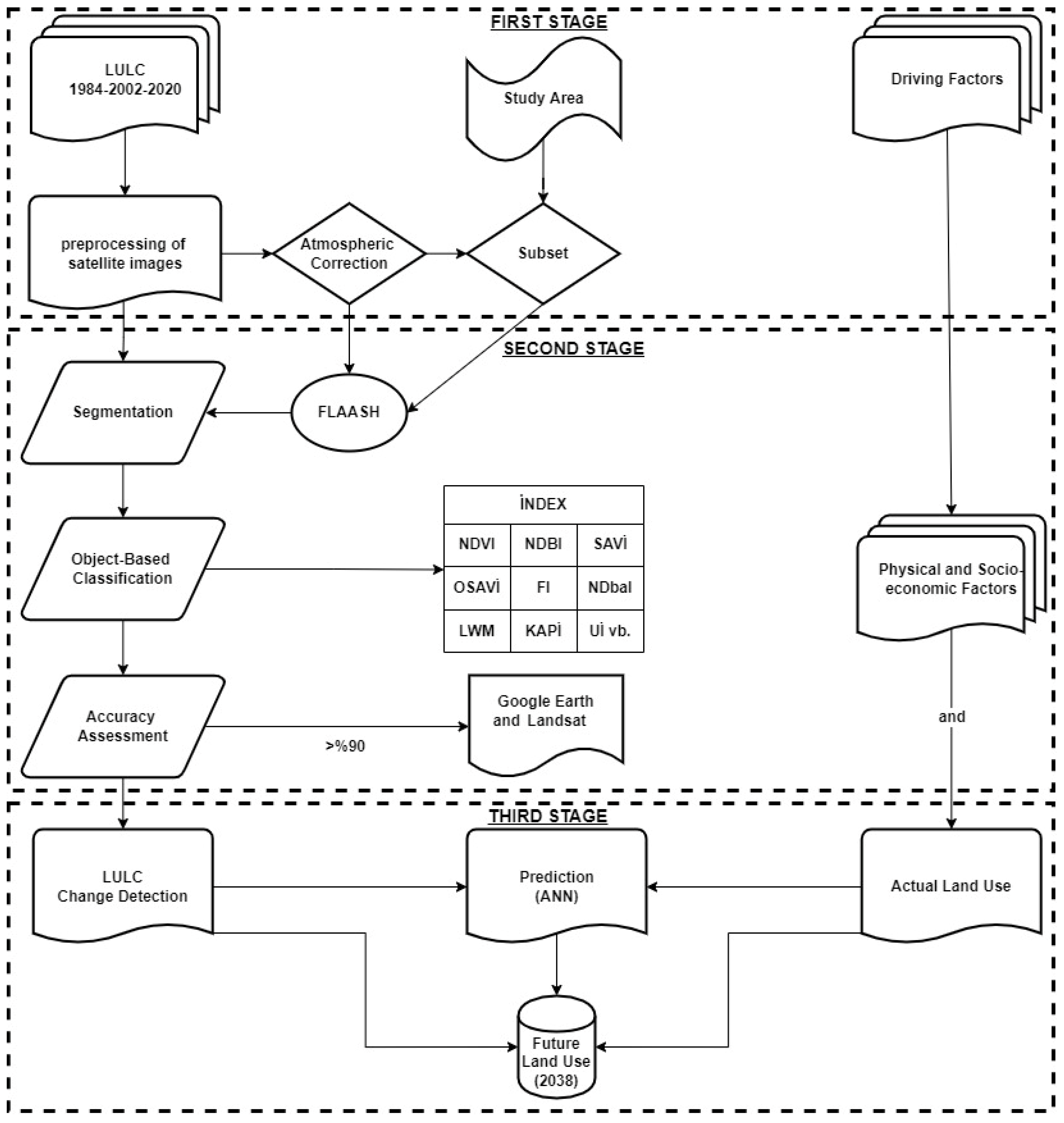
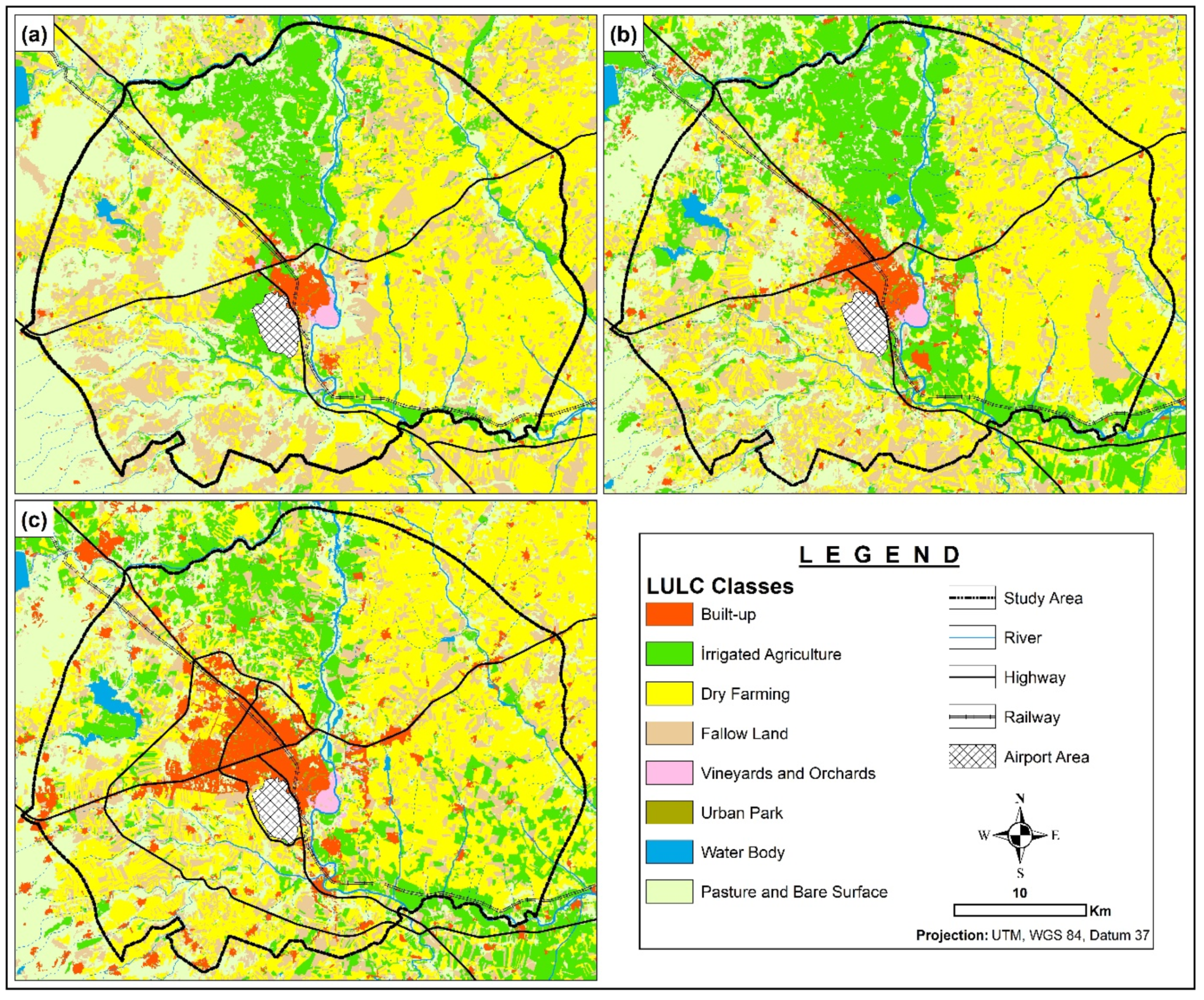

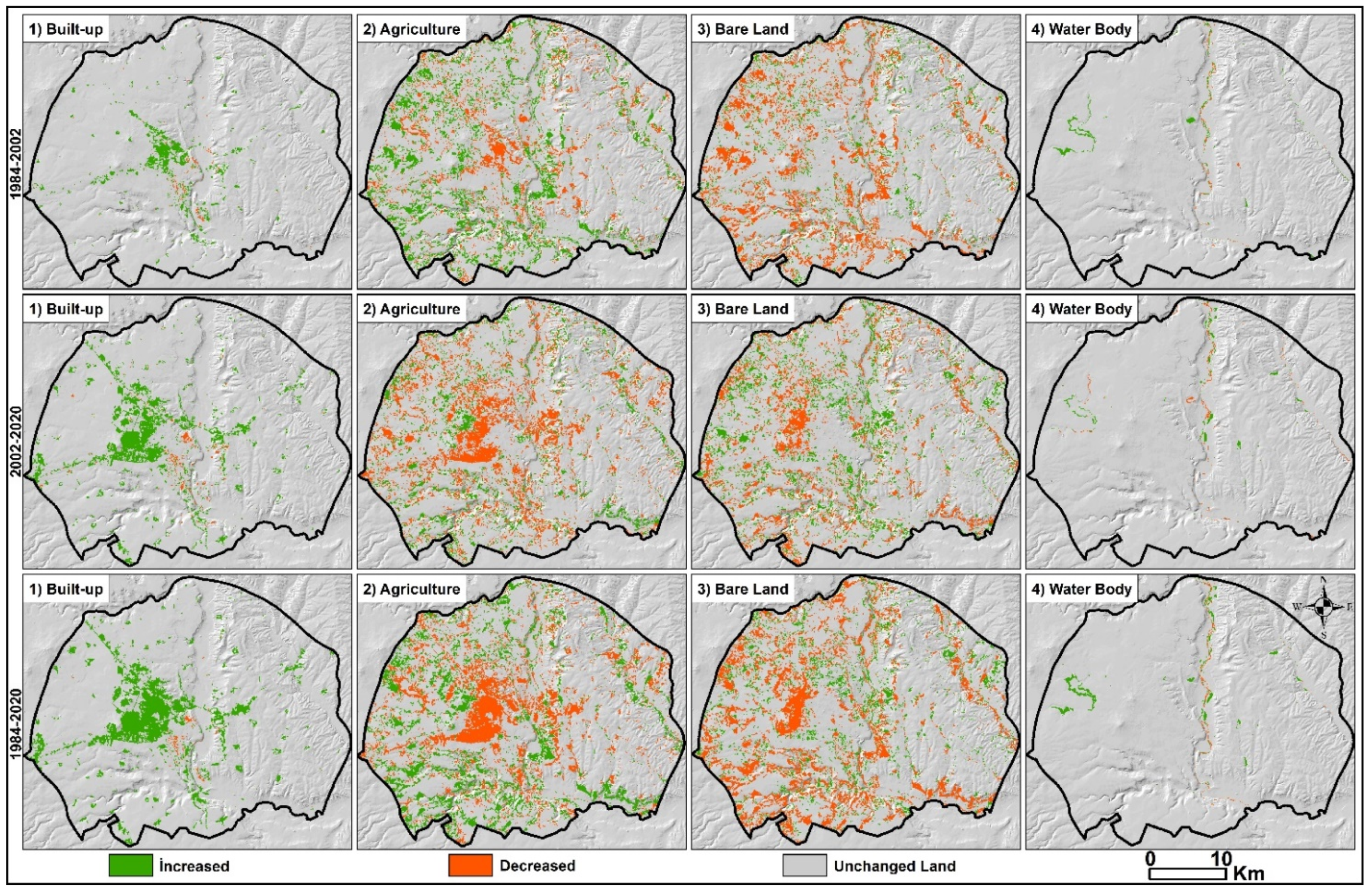
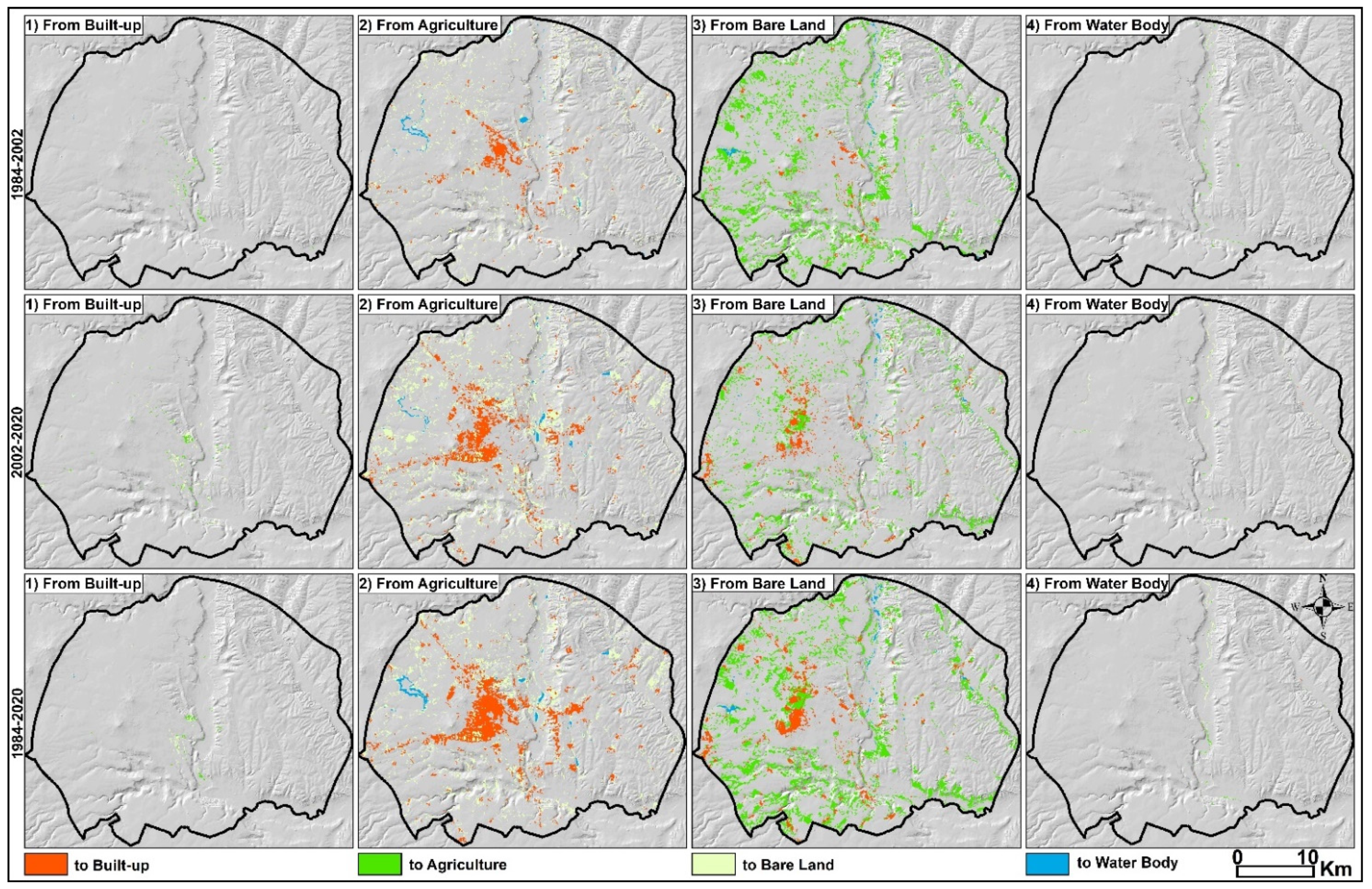
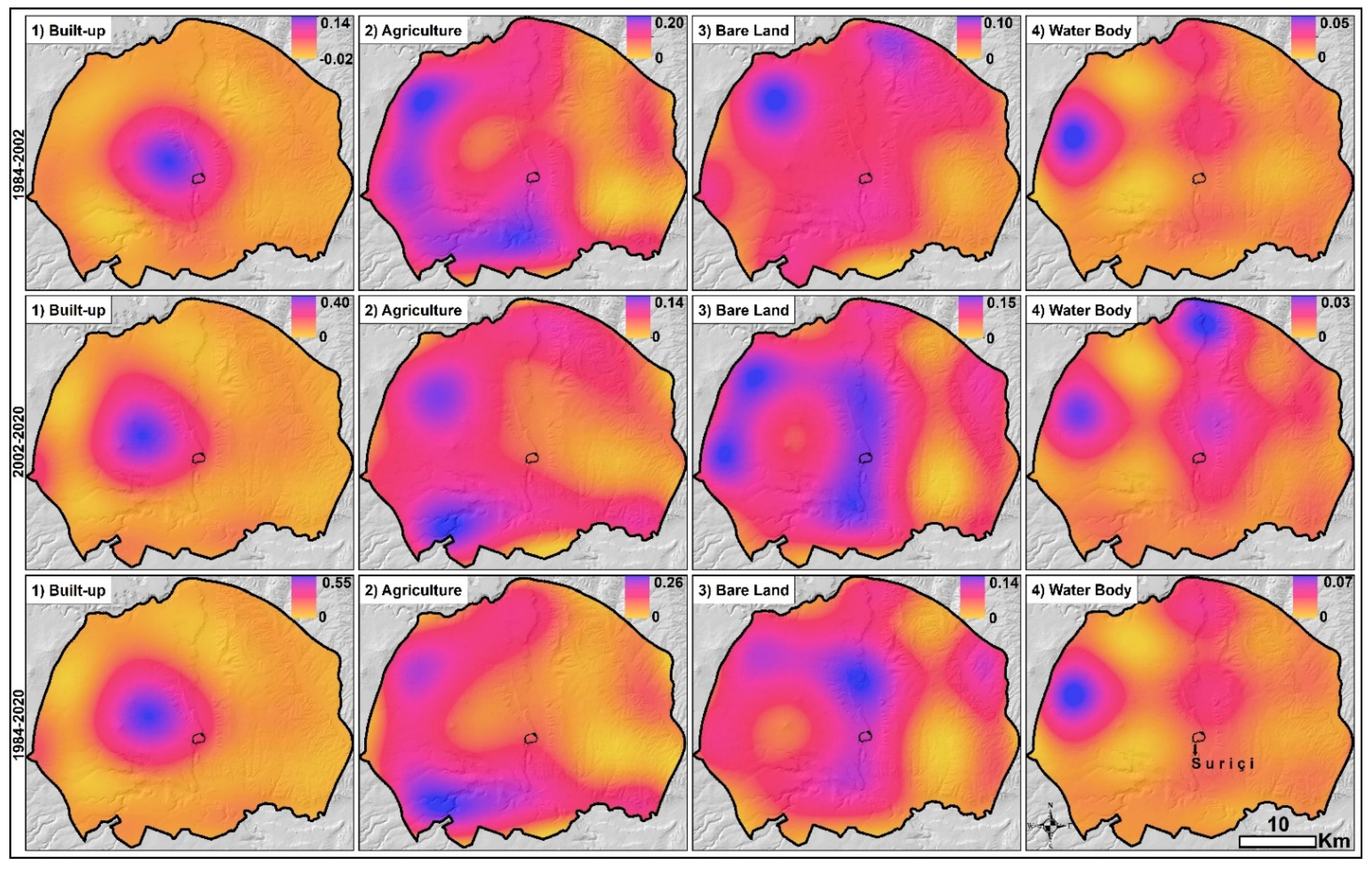
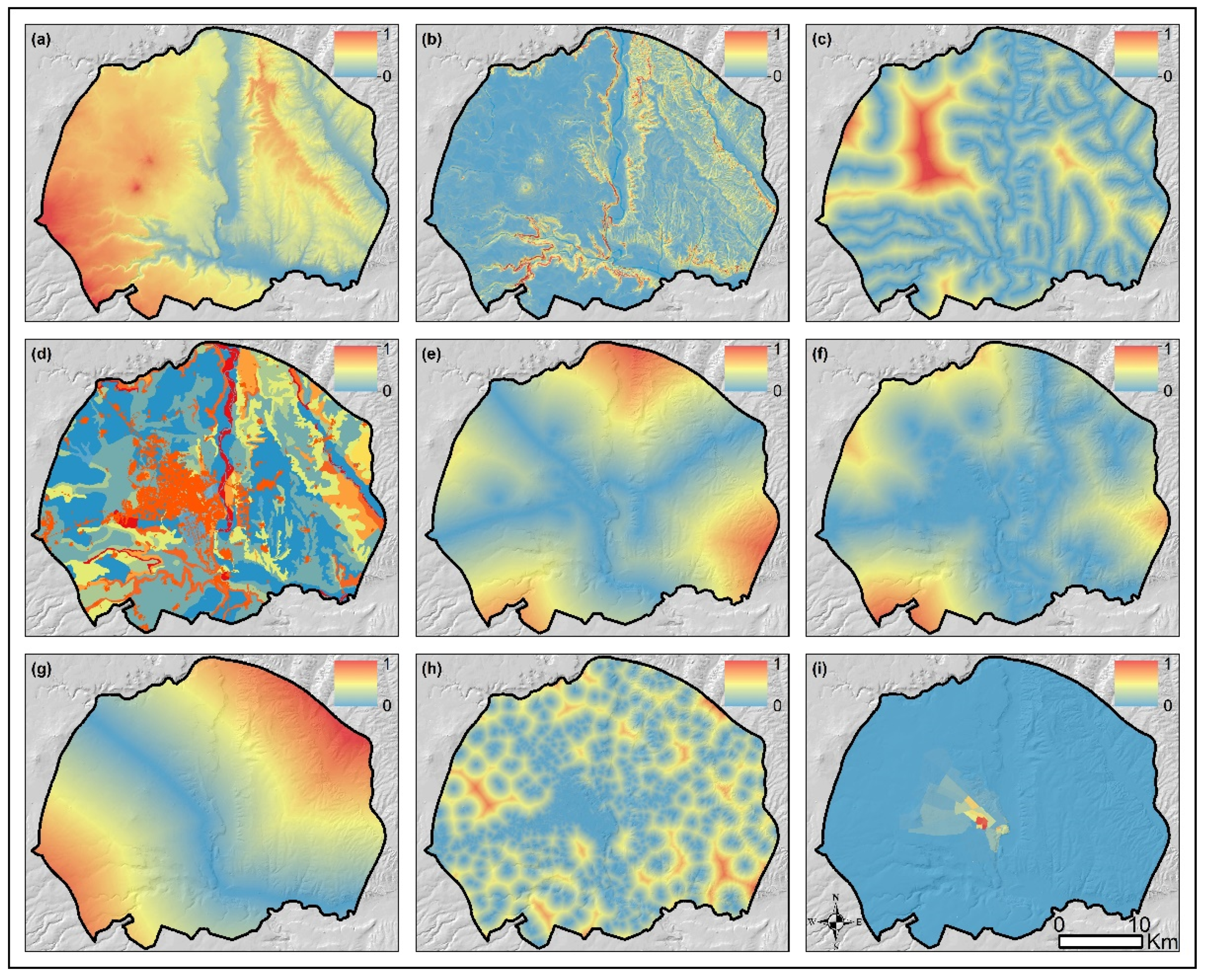

| Landsat Images | Spatial Resolution | Bands | Range | Path/Row | Acquisition Date |
|---|---|---|---|---|---|
| Landsat 4–5 TM | 30 m | 1,2,3,4 | 0.48–0.84 | 172/034 | 22 July 1984 |
| Landsat 7 ETM+ | 30 m | 1,2,3,4 | 0.48–0.83 | 172/034 | 16 July 2002 |
| Landsat 8 OLİ | 30 m | 2,3,4,5 | 0.44–0.86 | 172/034 | 25 July 2020 |
| 1984 | 2002 | 2020 | ||||
|---|---|---|---|---|---|---|
| LULC Classes | km2 | % | km2 | % | km2 | % |
| Built-up (BP) | 23 | 2.1 | 47 | 4.4 | 110 | 10.2 |
| İrrigated Agriculture (İA) | 170 | 15.8 | 235 | 21.8 | 161 | 14.9 |
| Dry Farming (DF) | 386 | 35.8 | 388 | 36.0 | 433 | 40.1 |
| Fallow Land (FL) | 215.3 | 20.0 | 198.6 | 18.4 | 162 | 15.0 |
| Vineyards (VY) | 5.2 | 0.5 | 5.7 | 0.5 | 6.6 | 0.6 |
| Urban Park (UP) | 0.3 | 0.03 | 0.7 | 0.1 | 2.4 | 0.2 |
| Water Body (WB) | 8.2 | 0.8 | 13 | 1.2 | 14 | 1.3 |
| Pasture/Bare (PB) | 271 | 25.1 | 191 | 17.7 | 190 | 17.6 |
| Total | 1079 | 100 | 1079 | 100 | 1079 | 100 |
| 1984 | BP | İA | DF | FL | VY | UP | WB | PB |
|---|---|---|---|---|---|---|---|---|
| Producer Accuracy | 97.2 | 94.4 | 97.3 | 84.5 | 96.5 | 85.7 | 97.2 | 94.9 |
| User Accuracy | 99.6 | 92.1 | 93.9 | 93.9 | 67.5 | 100 | 99 | 94.4 |
| Overall Accuracy | 93.7 | |||||||
| Kappa Coefficient | 0.91 | |||||||
| 2002 | ||||||||
| Producer Accuracy | 97.5 | 98.8 | 97.2 | 90.5 | 100 | 95.3 | 97.1 | 88.7 |
| User Accuracy | 98.7 | 91.7 | 99 | 88.7 | 100 | 93.9 | 99.7 | 97.9 |
| Overall Accuracy | 94.8 | |||||||
| Kappa Coefficient | 0.93 | |||||||
| 2020 | ||||||||
| Producer Accuracy | 97 | 99.1 | 98.4 | 95.9 | 97.1 | 82.1 | 97.8 | 85 |
| User Accuracy | 96.3 | 97.2 | 97.4 | 88.6 | 79.6 | 71.1 | 97.5 | 88.6 |
| Overall Accuracy | 95.6 | |||||||
| Kappa Coefficient | 0.94 |
| Total Change (%) | Annual Change (%) | |||||
|---|---|---|---|---|---|---|
| LULC Classes | 1984–2002 | 2002–2020 | 1984–2020 | 1984–2002 | 2002–2020 | 1984–2020 |
| Built-up | 51.1 | 57.3 | 79.1 | 2.8 | 3.2 | 4.4 |
| İrrigated Agriculture | 27.7 | −46.0 | −5.6 | 1.5 | −2.5 | −0.3 |
| Dry Farming | 0.5 | 10.4 | 10.9 | 0.02 | 0.6 | 0.6 |
| Fallow Land | −9.1 | −23.0 | −34.2 | −0.5 | −1.3 | −1.9 |
| Vineyards | 10.5 | 13.6 | 22.7 | 0.5 | 0.7 | 1.3 |
| Urban Park | 57.8 | 73.3 | 88.8 | 3.2 | 4.0 | 4.9 |
| Water Body | 36.9 | 7.1 | 41.4 | 2.0 | 0.4 | 2.3 |
| Pasture/Bare | −41.9 | −0.5 | −46.6 | −2.3 | −0.02 | −2.4 |
| Period | From/to | Built-up | Agriculture | Pasture/Bare | Water Body | Total Loss |
|---|---|---|---|---|---|---|
| 1984–2002 | Built-up | 20.0 | 1.53 | 0.9 | 0.02 | 2.5 |
| Agriculture | 19.4 | 708.1 | 47.2 | 3.9 | 70.6 | |
| Pasture/Bare | 7.8 | 118.2 | 139.4 | 3.5 | 129.5 | |
| Water Body | 0.009 | 1.5 | 1.01 | 5.5 | 2.5 | |
| Total Gain | 27.2 | 121.3 | 49.2 | 7.5 | 205.7 | |
| Chi-square = 3,069,529.5, df = 16, p-Level = 0.000, Cramer’s V = 0.6773, Overall Kappa = 0.76 | ||||||
| From/to | Built-Up | Agriculture | Pasture/Bare | Water Body | Total Loss | |
| 2002–2020 | Built-up | 42.1 | 2.0 | 3.5 | 0.02 | 5.5 |
| Agriculture | 46.6 | 695.1 | 83.9 | 3.5 | 133.9 | |
| Pasture/Bare | 23.9 | 71.2 | 91.2 | 2.1 | 97.2 | |
| Water Body | 0.08 | 0.9 | 3.2 | 8.8 | 4.1 | |
| Total Gain | 70.6 | 74.1 | 90.5 | 5.6 | 240.8 | |
| Chi-square = 3,009,415.0, df = 16, p-Level = 0.000, Cramer’s V = 0.6707, Overall Kappa = 0.72 | ||||||
| From/to | Built-Up | Agriculture | Pasture/Bare | Water Body | Total Loss | |
| 1984–2020 | Built-Up | 19.7 | 1.1 | 1.5 | 0.02 | 2.7 |
| Agriculture | 61.7 | 642.1 | 69.1 | 5.4 | 136.3 | |
| Pasture/Bare | 31.3 | 124.2 | 109.4 | 4.2 | 159.8 | |
| Water Body | 0.04 | 1.1 | 2.2 | 4.7 | 3.4 | |
| Total Gain | 93.1 | 126.5 | 72.8 | 9.7 | 302.2 | |
| Chi-square = 2,398,673.2, df = 16, p-Level = 0.000, Cramer’s V = 0.5988, Overall Kappa = 0.67 | ||||||
| LULC | Built-Up | Agriculture | Pasture/Bare | Water Body | |
|---|---|---|---|---|---|
| Cost Matrix | Built-up | 1 | 0 | 1 | 0 |
| Agriculture | 1 | 1 | 1 | 1 | |
| Pasture/Bare | 1 | 1 | 1 | 1 | |
| Water Body | 0 | 0 | 0 | 1 | |
| Weight of Neighborhood | 1 | 1 | 0.75 | 0.50 |
| Year | 2002 | 2011 | 2020 | 2038 | 2020–2038 | ||||||
|---|---|---|---|---|---|---|---|---|---|---|---|
| LULC | Actual | Predic. | Accur.% | Actual | Predic. | Accur.% | Actual | Predic. | Accur.% | Predic. | Differ.% |
| Built-up | 47.5 | 53.7 | 88.3 | 99.6 | 75 | 75.3 | 112.6 | 142.2 | 79.1 | 137.8 | +22.3 |
| Agriculture | 821.8 | 828.8 | 99.1 | 764.4 | 823.8 | 92.4 | 761.1 | 720.8 | 94.4 | 753.4 | −1.02 |
| Pasture/Bare | 196.1 | 182.1 | 92.8 | 200.1 | 182.7 | 91.2 | 190.3 | 200.4 | 94.9 | 172.9 | −9.1 |
| Water Body | 13 | 13.8 | 94.4 | 14.3 | 14 | 97.5 | 14.3 | 15 | 95.7 | 14.3 | −0.2 |
| Total | 1079 | 1079 | 100 | 1079 | 1079 | 100 | 1079 | 1079 | 100 | 1079 | |
| 2002 | Built-Up | Agriculture | Pasture/Bare | Water Body |
|---|---|---|---|---|
| Producer Accuracy | 0.61 | 0.54 | 0.56 | 0.88 |
| User Accuracy | 0.72 | 0.55 | 0.57 | 0.87 |
| Overall Accuracy | 0.78 | |||
| Kappa Coefficient | 0.65 | |||
| 2011 | ||||
| Producer Accuracy | 0.65 | 0.55 | 0.58 | 0.86 |
| User Accuracy | 0.75 | 0.58 | 0.67 | 0.88 |
| Overall Accuracy | 0.82 | |||
| Kappa Coefficient | 0.75 | |||
| 2020 | ||||
| Producer Accuracy | 0.76 | 0.75 | 0.62 | 0.88 |
| User Accuracy | 0.78 | 0.61 | 0.67 | 0.87 |
| Overall Accuracy | 0.84 | |||
| Kappa Coefficient | 0.77 |
Publisher’s Note: MDPI stays neutral with regard to jurisdictional claims in published maps and institutional affiliations. |
© 2022 by the authors. Licensee MDPI, Basel, Switzerland. This article is an open access article distributed under the terms and conditions of the Creative Commons Attribution (CC BY) license (https://creativecommons.org/licenses/by/4.0/).
Share and Cite
Çağlıyan, A.; Dağlı, D. Monitoring Land Use Land Cover Changes and Modelling of Urban Growth Using a Future Land Use Simulation Model (FLUS) in Diyarbakır, Turkey. Sustainability 2022, 14, 9180. https://doi.org/10.3390/su14159180
Çağlıyan A, Dağlı D. Monitoring Land Use Land Cover Changes and Modelling of Urban Growth Using a Future Land Use Simulation Model (FLUS) in Diyarbakır, Turkey. Sustainability. 2022; 14(15):9180. https://doi.org/10.3390/su14159180
Chicago/Turabian StyleÇağlıyan, Ayşe, and Dündar Dağlı. 2022. "Monitoring Land Use Land Cover Changes and Modelling of Urban Growth Using a Future Land Use Simulation Model (FLUS) in Diyarbakır, Turkey" Sustainability 14, no. 15: 9180. https://doi.org/10.3390/su14159180
APA StyleÇağlıyan, A., & Dağlı, D. (2022). Monitoring Land Use Land Cover Changes and Modelling of Urban Growth Using a Future Land Use Simulation Model (FLUS) in Diyarbakır, Turkey. Sustainability, 14(15), 9180. https://doi.org/10.3390/su14159180






